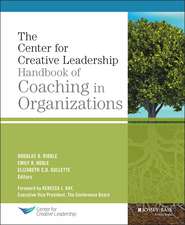Hidden Talent: How Leading Companies Hire, Retain, and Benefit from People with Disabilities
Editat de Mark L. Lengnick-Hallen Limba Engleză Hardback – 29 apr 2007 – vârsta până la 17 ani
Preț: 345.23 lei
Preț vechi: 476.01 lei
-27% Nou
Puncte Express: 518
Preț estimativ în valută:
66.06€ • 69.15$ • 54.98£
66.06€ • 69.15$ • 54.98£
Carte tipărită la comandă
Livrare economică 31 martie-14 aprilie
Preluare comenzi: 021 569.72.76
Specificații
ISBN-13: 9780275992897
ISBN-10: 0275992896
Pagini: 168
Dimensiuni: 156 x 235 x 20 mm
Greutate: 0.42 kg
Editura: Bloomsbury Publishing
Colecția Praeger
Locul publicării:New York, United States
ISBN-10: 0275992896
Pagini: 168
Dimensiuni: 156 x 235 x 20 mm
Greutate: 0.42 kg
Editura: Bloomsbury Publishing
Colecția Praeger
Locul publicării:New York, United States
Notă biografică
Mark L. Lengnick-Hall is Professor of Management in the College of Business at the University of Texas, San Antonio. His research and teaching interests include the employment of people with disabilities, human resource management in the knowledge economy, and implementing information technology in organizations. He is coauthor of Human Resource Management in the Knowledge Economy, Compensation Decision Making, and Interactive Human Resource Management and Strategic Planning (Quorum, 1990), and his articles have been published in a wide array of journals, including Academy of Management Review, Personnel Psychology, HR Magazine, Journal of Organizational Behavior, and the Wall Street Journal.
Cuprins
PrefaceRobert R. HullIntroductionMark L. Lengnick-HallSection One The Problem and the Opportunity: People with Disabilities Need Jobs and Employers Need WorkersChapter 1 Where Will Businesses Find the Workers They Need in the Future?Jodi Messer PelkowskiChapter 2 Why Employers Don't Hire People with DisabilitiesMark L. Lengnick-Hall and Philip GauntSection Two Solutions: What Some Leading Companies Are Doing to Hire and Retain People with DisabilitiesChapter 3 Hewlett-PackardPhilip GauntChapter 4 Dow Chemical CompanyRobert R. HullChapter 5 SunTrust BanksNancy Bereman and Stephanie J. HargraveChapter 6 A&F Wood ProductsPhilip GauntChapter 7 Giant Eagle Inc.Nancy Bereman and Stephanie J. HargraveChapter 8 MicrosoftMark L. Lengnick-HallChapter 9 Marriott InternationalRobert R. HullSection Three Lessons Learned about Hiring and Retaining People with DisabilitiesChapter 10 The Business Case for Hiring People with DisabilitiesMark L. Lengnick-HallChapter 11 Creating a Disability-Friendly Organizational Culture and ClimateMark L. Lengnick-HallChapter 12 ConclusionMark L. Lengnick-HallAppendixesAppendix 1 Tax Incentives for Hiring People with DisabilitiesRobert R. HullAppendix 2 Resources for Hiring People with DisabilitiesRobert R. HullAppendix 3 The Cerebral Palsy Research FoundationRobert R. HullAppendix 4 The Americans with Disabilities Act (1990)Mark L. Lengnick-HallNotesIndexAbout the Editor and Contributors
Recenzii
Lengnick-Hall has edited a highly readable and informative book that attempts to persuade readers of the benefits of hiring people with disabilities. Although employers may be hesitant to hire disabled persons for various reasons, Lengnick-Hall and his academic and research colleagues dispel myths surrounding disabled employees, citing examples of companies that were proactive in hiring the disabled and thrived as a result. The seven case studies included in the text, each one its own chapter, read like a conversation, with practical advice and lessons learned provided at the end. Further resources include a section on tax incentives for employers and a basic introduction to the Americans with Disabilities Act (1990). Although brief, the seven case studies, along with the research discussed in the book, successfully highlight the message that hiring people with disabilities puts companies at a competitive advantage. Any individual interested in learning about this topic, and particularly managers in the early stages of changing organizational culture for purposes of being more disability-friendly, would gain from reading this book..Recommended. General readers; all levels of undergraduate students; and practitioners.
Editor Lengnick-Hall compiles new essays and case studies (not previously published) about how companies have benefited from the hiring and retaining of people with disabilities. The pieces include suggestions on how to create organizational cultures and climates that are disability-friendly. Unlike in many books that present strategies for people entering the workforce with disabilities, these contributors (mostly academics) focus on companies that are leaders in hiring, retaining, and valuing employees with disabilities, illustrating principles that can improve any organization that is committed to a diverse workforce..Helpful appendixes include a list of federal tax incentives for hiring people with disabilities, a list of government agencies and business-sponsored organizations that help in the hiring of people with disabilities, and an overview of the Americans with Disabilities Act of 1990. The distinct research and presentations make this volume suitable for most public and academic libraries.
The Rehabilitation Act of 1978 and Americans with Disabilities Act of 1990 were bold first steps in ensuring the 20 million considered disabled in the US would be treated equitably, but unemployment of the disabled has remained at about 25 to 30 percent from their enactment to the present. This leaves a significant number of people who are well-trained and ready to work. This collection of 12 articles and case studies shows how successful companies such as Hewlett-Packard, Dow Chemical Company, Microsoft and Marriott International have found a significant business case for hiring people with disabilities and creating a disability-friendly culture and climate. Along with these exemplars contributors describe why employers do not hire the disabled and how they learn about the high quality of work and loyalty of such employees and other incentives that go straight to the bottom line, such as tax incentives currently available.
Editor Lengnick-Hall compiles new essays and case studies (not previously published) about how companies have benefited from the hiring and retaining of people with disabilities. The pieces include suggestions on how to create organizational cultures and climates that are disability-friendly. Unlike in many books that present strategies for people entering the workforce with disabilities, these contributors (mostly academics) focus on companies that are leaders in hiring, retaining, and valuing employees with disabilities, illustrating principles that can improve any organization that is committed to a diverse workforce..Helpful appendixes include a list of federal tax incentives for hiring people with disabilities, a list of government agencies and business-sponsored organizations that help in the hiring of people with disabilities, and an overview of the Americans with Disabilities Act of 1990. The distinct research and presentations make this volume suitable for most public and academic libraries.
The Rehabilitation Act of 1978 and Americans with Disabilities Act of 1990 were bold first steps in ensuring the 20 million considered disabled in the US would be treated equitably, but unemployment of the disabled has remained at about 25 to 30 percent from their enactment to the present. This leaves a significant number of people who are well-trained and ready to work. This collection of 12 articles and case studies shows how successful companies such as Hewlett-Packard, Dow Chemical Company, Microsoft and Marriott International have found a significant business case for hiring people with disabilities and creating a disability-friendly culture and climate. Along with these exemplars contributors describe why employers do not hire the disabled and how they learn about the high quality of work and loyalty of such employees and other incentives that go straight to the bottom line, such as tax incentives currently available.












